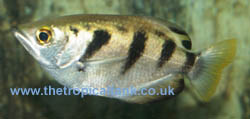

Photos © Sean Evans
|
| Common name: | Archerfish, Large-Scaled Archerfish |
| Scientific name: | Toxotes chatareus |
| Synonyms: | |
| Size: | Up to 16" (40cm), but usually somewhat smaller. |
| Origin: | India and Southeast Asia to Australia. |
| Tank setup: | Larger aquarium, with plants or roots going down into or out from the water.
Ideally, use a deep tank part-filled, with a tight-fitting lid, to provide a space above the water where insects can be introduced. |
| Compatibility: | Fairly peaceful with similar sized fish. |
| Temperature: | 25-30oC (77-86oF) |
| Water chemistry: | Fairly hard, neutral to alkaline (pH 7.0-8.5). Often sold in freshwater when young, but they
should be transferred to brackish water (around 1.005 - 1.010 sg) for their long term health. |
| Feeding: | Carnivorous: an inectivore which feeds from the surface. Most aquarium foods eaten, include a variety of frozen/live foods. |
| Sexing: | Unknown |
| Breeding: | Captive breeding of Archerfish is rare. Spawning takes place near the surface and a large number of floating eggs are laid. |
| Comments: |
The archerfish are known for their ability to shoot down insects with a jet of water. They can be aggressive with their own kind,
so it is advisable to keep either a single specimen, or a small group of similar sized individuals, to spread out any aggression.
This species may be confused with other similar archerfish such as Toxotes jaculatrix (Common/Banded Archerfish), Toxotes microlepis (Small-scaled Archerfish)
and Toxotes oligolepis (Western Archerfish). It can be differentiated from the common Archer (T. jaculatrix) by the presence of five dorsal spines (as opposed to four).
|





